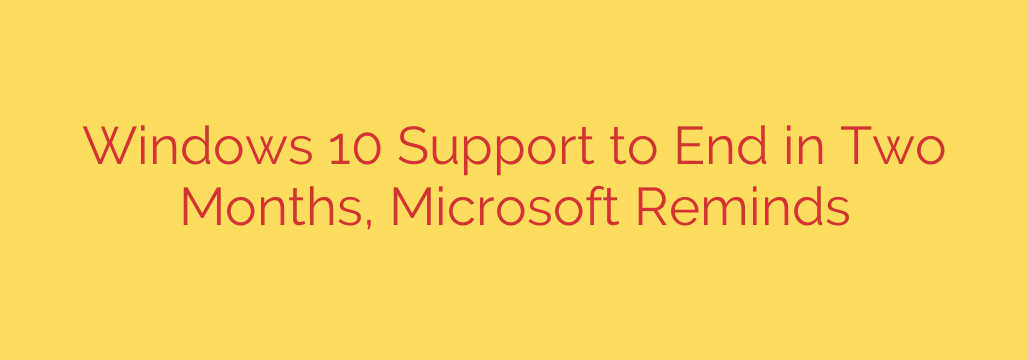
The Final Countdown: Windows 10 End of Support is Just Months Away
The clock is ticking for millions of Windows 10 users. Microsoft is issuing its final reminders that the official end-of-support date for the popular operating system is fast approaching. If you are still running Windows 10, it is crucial to understand what this means and what steps you need to take to protect your data and privacy.
The official end-of-life date for most versions of Windows 10 is October 14, 2025. After this date, devices running the operating system will no longer receive critical security updates, non-security fixes, or assisted technical support from Microsoft.
What “End of Support” Means for You
When an operating system reaches its end of life, it doesn’t suddenly stop working. Your computer will still turn on, and your applications will still run. However, the silent, protective shield that Microsoft provides will be gone.
Here’s what will cease after the October 2025 deadline:
- No More Security Updates: This is the most significant risk. Cybercriminals actively search for vulnerabilities in software. Without ongoing security patches, any new flaws discovered in Windows 10 will remain unpatched forever, leaving your system wide open to malware, ransomware, and viruses.
- No Bug Fixes or New Features: Any glitches or performance issues that arise after the deadline will not be fixed. You will also miss out on any software innovations.
- No Official Technical Support: If you run into a problem, Microsoft’s support agents will no longer be available to assist you.
Continuing to use Windows 10 after the support deadline exposes your personal information, financial data, and digital identity to significant and unnecessary security threats.
Your Action Plan: What to Do Before the Deadline
Procrastinating is not an option when it comes to your digital security. Fortunately, you have several clear paths forward to ensure your devices remain protected.
1. The Best Option: Upgrade to Windows 11
For most users, this is the recommended solution. Windows 11 is a free upgrade for eligible Windows 10 PCs and offers a modern interface, enhanced security features like a hardware-based “root of trust,” and ongoing support for years to come.
To see if your current PC can run Windows 11, you can use Microsoft’s PC Health Check app. This tool will analyze your hardware (processor, RAM, storage, and TPM 2.0 requirements) and tell you if your system is compatible. If it is, the upgrade process is straightforward and can be initiated through your Windows Update settings.
2. For Incompatible Hardware: The Extended Security Updates (ESU) Program
Microsoft recognizes that not all hardware can support Windows 11. For businesses and individuals who cannot upgrade their machines, there is a paid option called the Extended Security Updates (ESU) program.
- This is a subscription service that provides security updates for up to three additional years.
- The ESU program is a temporary bridge, not a long-term solution. The cost is expected to increase each year to encourage migration to a modern OS.
- It only provides security patches; you will not receive any new features or non-security bug fixes.
This option is designed for those who have a critical need to keep using older hardware and are willing to pay for a temporary safety net.
3. The Final Alternative: Invest in a New PC
If your computer is more than a few years old and does not meet the requirements for Windows 11, the most practical long-term solution may be to purchase a new device. Modern PCs are not only more powerful and efficient, but they are also built with the latest security standards in mind and come with Windows 11 pre-installed. While it requires an investment, it guarantees a secure and fully supported computing experience.
Expect Full-Screen Reminders
To ensure users are aware of the impending deadline, Microsoft has begun displaying full-screen notifications on non-managed Windows 10 PCs. These pop-ups are a direct and urgent reminder to take action. Do not ignore them—they are a clear signal that the time to plan your transition is now.
Don’t wait until the last minute. Check your PC’s eligibility for Windows 11 today and make a plan to ensure you remain on a secure, supported, and modern operating system.
Source: https://www.bleepingcomputer.com/news/microsoft/microsoft-reminds-users-of-windows-10-retirement-in-october/








